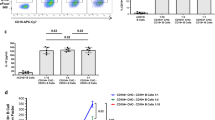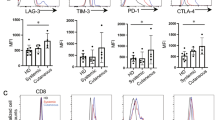Abstract
Acute graft-versus-host disease (GVHD) is a complication of bone marrow transplantation (BMT). The histopathologic features used to diagnose GVHD are non-specific, and may be secondary to chemotherapy or irradiation given before BMT. The presence of apoptotic keratinocytes or activated CTL may distinguish GVHD from conditioning effects. This study investigated the relationship in BMT recipients between keratinocyte apoptosis and the effects of conditioning regimens or immune-mediated GVHD. Inflammatory cells, apoptotic keratinocytes, and CTL expressing TIA-1 (a molecule associated with the lytic granules of CTL) were quantitated in allogeneic and autologous recipients. Allogeneic recipients could exhibit keratinocyte apoptosis secondary to a combination of conditioning effects and immune-mediated GVHD. In contrast, autologous recipients should show conditioning effects only. ‘Capped’ TIA-1-positive lymphocytes and apoptotic keratinocytes were much more frequent in the allogeneic group than the autologous group (16.1% of total TIA-1 positive lymphocytes vs4.5%, P = 0.02; and 37.6/mm2 vs 3.9/mm2, P = 0.005, respectively), although there was some overlap in their frequency. Among individual recipients of allogeneic BMT, the number of epidermal lymphocytes or macrophages correlated with the number of apoptotic keratinocytes. A similar, but weaker, correlation was seen between the number of ‘capped’ TIA-1-positive lymphocytes and apoptotic keratinocytes. No such relationship was seen in autologous recipients. In allogeneic recipients, TIA-1 expressing CTL were seen in intimate contact with apoptotic keratinocytes, some of which also had detectable cytoplasmic TIA-1. No CTL/keratinocyte interactions were identified in autologous recipients. Our results suggest that apoptotic keratinocytes arise in the skin of BMT patients due to both GVHD and conditioning effects, and that the keratinocyte damage in GVHD is mediated by both CTL-dependent and -independent mechanisms. Increased numbers of apoptotic keratinocytes, in the presence of increased epidermal lymphocytes or ‘capped’ TIA-1-expressing lymphocytes, support a diagnosis of GVHD, but must be interpreted in the context of clinical information and other histopathologic findings.
This is a preview of subscription content, access via your institution
Access options
Subscribe to this journal
Receive 12 print issues and online access
$259.00 per year
only $21.58 per issue
Buy this article
- Purchase on Springer Link
- Instant access to full article PDF
Prices may be subject to local taxes which are calculated during checkout
Similar content being viewed by others
Author information
Authors and Affiliations
Rights and permissions
About this article
Cite this article
Jerome, K., Conyers, S., Hansen, D. et al. Keratinocyte apoptosis following bone marrow transplantation: evidence for CTL-dependent and -independent pathways. Bone Marrow Transplant 22, 359–366 (1998). https://doi.org/10.1038/sj.bmt.1701344
Received:
Accepted:
Published:
Issue Date:
DOI: https://doi.org/10.1038/sj.bmt.1701344



